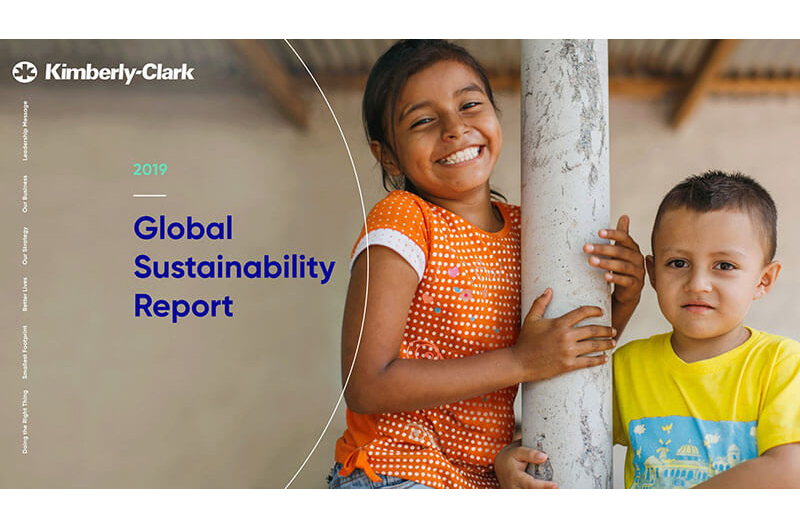Irving, Texas-based Kimberly-Clark recently announced its new 2030 sustainability strategy and goals, which are aimed at addressing the social and environmental challenges of the next decade. The company committed to improve the lives and well-being of one billion people in underserved communities around the world with the smallest environmental footprint.
“These extraordinary times remind us why our purpose is more important than ever,” said Mike Hsu, chairman and CEO of Kimberly-Clark. “Our values, that have guided us for nearly 150 years, will continue to shape our response to the challenges ahead. I am inspired by our ambition to advance the well-being of one billion people around the world and proud of the significant environmental commitments that we are making.”
The strategy is outlined in the company’s 2019 Global Sustainability Report, which reflects progress towards the company’s Sustainability 2022 strategy and its pivot to 2030.
“It’s great to see Kimberly-Clark setting such an ambitious new social goal to 2030,” said Sally Uren, chief executive of Forum for the Future. “There is also no doubt that we have entered a decade where decisive action will be critical if we hope to survive and thrive through the next century and beyond.”
Kimberly-Clark and its trusted brands, including Huggies, Kleenex, Andrex, Cottonelle, Scott, Kotex and Depend, deliver essentials to one quarter of the world’s population every day. Yet millions around the world still lack access to basic products and solutions. Meeting these unmet societal needs is the foundation for the company’s sustainability strategy in its new ten-year commitment.
The new goal will create positive social outcomes by creating shared value in three areas: caring for the health and well-being of people at all stages of life; challenging stigmas and championing the progress of women everywhere; and championing a world where all enjoy access to clean water and sanitation.
“We make lives better when we break down barriers and create opportunities with our purpose-driven brands and products,” said Alison Lewis, chief growth officer for Kimberly-Clark. “To reach a billion people is certainly an ambitious goal that requires a significant step change from our previous efforts, and we are ready to take it on.”
A strong and enduring focus on the smallest environmental footprint is just as essential to helping people live a better life, says the company. For this reason, Kimberly-Clark’s sustainability strategy focuses on the areas where it can make the biggest difference – climate, forests, water and plastics.
“Kimberly-Clark’s success is dependent on innovating new ways to give consumers the essentials they need while safeguarding natural systems and the life they support,” said Lisa Morden, VP of safety, sustainability and occupational health, Kimberly-Clark. “That means eliminating waste and recovering resources; protecting forests of high carbon, biodiversity and cultural value; cutting greenhouse gas emissions in line with climate science; and building strong water stewardship practices where it matters most.”
Each area of the new sustainability strategy aims to reduce the footprint by half:
- Carbon Footprint – The company is committed to reduce the carbon footprint of its operations and supply chain by 50 percent for absolute Scope 1 and Scope 2 GHG emissions (direct and indirect) from its operations, as well as a 20 percent reduction in absolute Scope 3 GHG emissions from purchased goods and services and end of life treatment of sold products.
- Forest Footprint – Kimberly-Clark will continue its previously stated goal to reduce its Natural (Northern) Forest Fiber footprint by 50 percent by 2025 and increase use of environmentally preferred fibers such as plantation-grown wood, alternative non-wood and recycled fibers. In addition, the company’s 2030 goals will tackle the challenges posed by climate change and biodiversity loss, and the impact on Indigenous communities, and communities that depend on forests for their livelihoods.
- Water Footprint – By 2030, Kimberly-Clark intends to reduce its water footprint by 50 percent in water-stressed regions by creating meaningful improvements in the supply chain and the surrounding communities. The impact of water insecurity and water scarcity is felt across the value chain, from the sources of fiber to the manufacturing facilities.
- Plastics Footprint – Kimberly-Clark will reduce its use of new, fossil-fuel based plastics by 50 percent through delivery of solutions that use more renewable materials and can be regenerated after use. The strategy builds on the company’s previous leadership in manufacturing waste diversion to tackle single-use plastics in its products and packaging, and support innovation in waste collection and circular systems.
To download the company’s 2019 Global Sustainability Report, click here.

